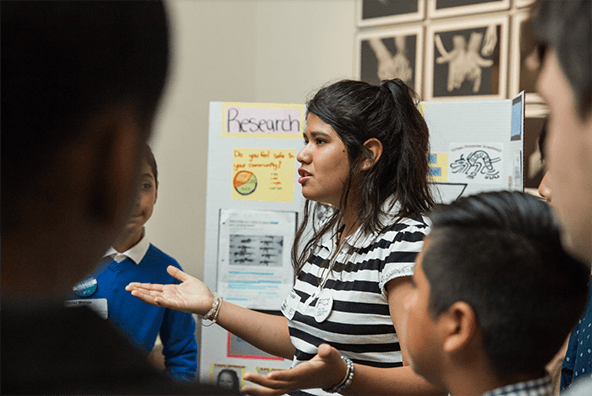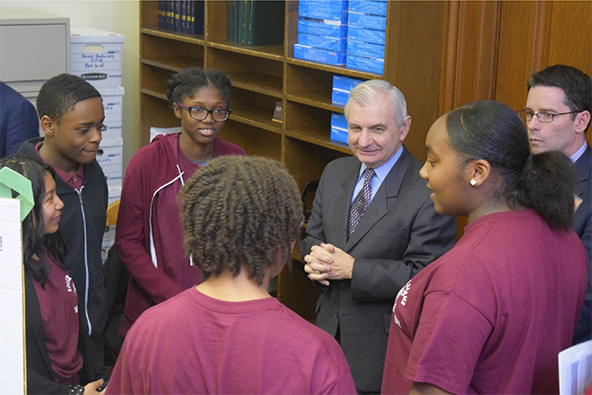 Students from Urban Promise Academy in Oakland, California, advocate for a youth council to be created within Oakland’s Department of Violence Prevention. (Photo courtesy of Generation Citizen)
Students from Urban Promise Academy in Oakland, California, advocate for a youth council to be created within Oakland’s Department of Violence Prevention. (Photo courtesy of Generation Citizen)
Yascha Mounk, a Harvard University lecturer and expert on crises of liberal democracy, recently issued a dire warning. “If current trends continue for another 20 or 30 years,” he said, “democracy will be toast.”
When considering the general state of the current US political system, other prominent political scientists might agree this assessment is not just fantastical conjecture. Generations of young people growing up in the United States have witnessed a sustained institutional disregard for equal rights, freedom of speech, voting rights, and access to decent housing. Young people in this era are particularly disillusioned about a democracy in which Twitter wars at the federal level become an acceptable substitute for dialogue and debate about substantive matters. The logical reaction from young people is to discount democracy as a fundamentally unfair and corrosive system, and an abstract and ineffective concept, rather than a community-centric vibrant set of behaviors and practices.
Fundamentally reforming and improving our democracy depends on repairing its very foundation of citizen representation and participation. And reform requires infrastructure that guarantees citizen input in governance (such as fair and equitable access to the polls), a free, fair, and robust media, and a political system that lessens the role of money in politics. Civic participation and democracy are synonymous.
But democracy also requires a citizenry capable of holding politicians accountable for substance instead of chicanery. To this end, ensuring that young people are both prepared and motivated to be the next stewards of our democracy is a crucial and oft-ignored condition for an improved political system. To remake our institutions and shore up democracy for generations to come, the most impactful place to start is with our educational system.
Are you enjoying this article? Read more like this, plus SSIR's full archive of content, when you subscribe.
Many schools have failed to prepare our youngest citizens to become stewards of democracy, possessing the knowledge and skills required for active and engaged citizenship. Statistics demonstrating this failure are plentiful: Only one-third of Americans can name all branches of government, and one-third cannot name any at all. 37 percent of Americans cannot name any of the rights guaranteed in the first amendment. And perhaps the most worrisome statistic: Only 33 percent of Americans born after 1980 consider democracy essential, while 24 percent of young people consider democracy a bad way to govern a country.
Increased and enhanced youth civics education is often cited as the solution to this problem. Re-prioritizing civics is logical and important. Whereas previous generations often took as many as three government courses before graduating from high school, students today often take one semester, if any. Educators are not taught how to teach civics education effectively, and resources from the federal government, states, and districts alike are sparse on the topic.
Just like structural fixes to our democracy, civics education is important, but insufficient on its own. The challenge is to reprioritize what schools teach overall, how it is taught, and to whom is it accessible. Over time, schools have succumbed to a myopic focus on issuing high school diplomas as an educational end for some students, college admission for others, and scores on high-stakes standardized tests for all. We cannot divorce our tenuous political environment from an education system that has become too focused on individual student success, with minimal focus on the common civic good.
Today’s nationwide toxic environment provides an impetus for articulating a more inspiring and citizen-centric vision for our public schools. This new vision includes re-imagining schools as laboratories of democracy, enlisting young people as co-collaborators with educators and local community members as partners in constructing the democracy our country both needs and deserves. Rather than exhorting young people to understand a staid conceptualization of democracy that reduces their own agency in the ever-changing American narrative, there is an opportunity for schools to engage our youth as legitimate political actors who can help us re-envision the very practice and values associated with democracy.
We can transform schools into beacons of democracy by ensuring that schools focus on centering education in the communities in which they are located, by constructing classes that are relevant to students’ lives, and by creating a democratic culture within school walls.
The process begins with a greater respect for the community in which school are situated. Students need to understand that the community is a place where citizens make their wants and needs known, and work together to solve communal challenges. Community members need to see the success of young people as relevant to the success of the community. Elected officials can learn to recognize students as purveyors of important local civic knowledge, capable of informing the most complex policy debates. Young people have a place in the community’s discourse and action, and it is important for them to experience the messiness and the satisfaction alike of the democratic process.
As an example, students in the Generation Citizen program in New York City recently responded to the debate around monuments by taking a proactive approach of lobbying the city to build memorials dedicated to African-American abolitionists. The students studied historical movements, noted the lack of representation in monuments throughout New York City, and met with the Mayor’s office to plan next steps. An education that included Action Civics provided an opportunity for them to experience citizenship in their community, while also understanding the shared history of the abolitionist movement. As a result, and most importantly, the students became excited about their coursework. Education, and democracy, were not abstract concepts to them but real issues that they were helping to mold, shape, and change.
 Students at Roger Williams Middle School in Providence, Rhode Island, meet with US Senator Jack Reed at Generation Citizen’s Civics Day. (Photo courtesy of Generation Citizen)
Students at Roger Williams Middle School in Providence, Rhode Island, meet with US Senator Jack Reed at Generation Citizen’s Civics Day. (Photo courtesy of Generation Citizen)
The focus on the community also allows classes to become relevant and intersectional. Math comes to life as students analyze traffic patterns and determine the ramifications of the local tax bond structure. English class involves analyzing articles in the local paper, and learning persuasive communication skills through debating the merits of local policy.
Earth Force is an organization that integrates real-world science problems with civic problem solving. As an example of one type of activity, through a partnership between government agencies, business, schools, and local parks, students explore the root causes of stormwater runoff in their neighborhoods and develop sustainable solutions. In another partnership with Colorado Parks and Wildlife, students monitor water quality and watershed health, and use the data to educate fellow citizens and inform decision-makers about the condition of Colorado’s water.
Beyond classes, the school itself can embody this community emphasis by becoming a place where students co-create a school culture that reflects the principles of democracy. In this type of democratic school, one which prioritizes student’s voices and creates the space for deliberative discussion, students find meaning in education, and become the producers and creators a democracy requires.
Lowell, Mass., is an example of a community that has embraced the importance of re-envisioning education through a democratic lens. The city itself has become increasingly diverse and a hub for immigrant populations, but the elected officials do not currently reflect the city’s changing demographics. The district has begun to construct its school environment with an explicitly democratic focus, enlisting Action Civics education programs in which young people take action on local issues they care about. In this way, they proactively contribute to a democratic school culture.
In turn, the district is working to ensure that its students are prepared for citizenship, while simultaneously working to transform the community of Lowell. Recent Lowell classes have focused on gun control by working with the police department to create a gun buy-back program and founding a food pantry within the school to support students who were coming to school hungry.
Our democracy may indeed be at risk, but an appreciation for our unprecedented times opens up unprecedented possibilities. A foundational reorientation of the purpose of public education can enable our youngest generation to not only understand democracy but also participate in creating a better version of it. We may have not yet created a democracy stable enough for future generations. But young people can help to create a better one.
Support SSIR’s coverage of cross-sector solutions to global challenges.
Help us further the reach of innovative ideas. Donate today.
Read more stories by Sylvia Rousseau & Scott Warren.

